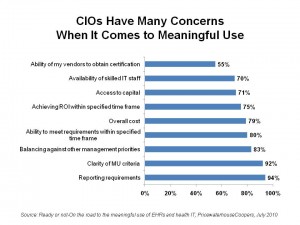 While 1 in 2 health CIOs say they’ll be prepared to apply for stimulus funding to adopt electronic health records in 2011, 80% are concerned about their ability to meet the requirements of meaningful use (MU). This lack of confidence on the road to MU is based on a host of challenges, from reporting requirements and lack of clarity of MU criteria to availability of IT talent and worries about access to capital.
While 1 in 2 health CIOs say they’ll be prepared to apply for stimulus funding to adopt electronic health records in 2011, 80% are concerned about their ability to meet the requirements of meaningful use (MU). This lack of confidence on the road to MU is based on a host of challenges, from reporting requirements and lack of clarity of MU criteria to availability of IT talent and worries about access to capital.
PricewaterhouseCoopers’ Health Research Institute (PwC) surveyed 120 health care CIOs and IT executives and published the detailed findings in the report, Ready or not: On the road to meaningful use of EHRs and health IT. Respondents were members of the College of Healthcare Information Management Executives (CHIME).
The challenges fall into four barriers, PwC says:
- Lack of clarity of the meaningful use criteria
- Shortage of IT staff
- Vendor readiness and concerns about consolidation
- Capabilities of providers’ existing infrastructures to maintain the HIT systems.
On the upside, health CIOs see many benefits that will accrue to those providers who successfully adopt and manage EHRs, including better aligning with physicians and increasing productivity. Gaining market advantage is the third-ranked expected positive outcome.
How to get ‘there?’ PwC offers “five mile markers” on the road to MU: to establish governance, balance priorities, forge public-private partnerships, make the patient the purpose, and collaborate with physicians and health plans.
Health Populi’s Hot Points: PwC’s survey reveals the real-time tensions of health care CIOs who are trying to balance critical day-to-day priorities of managing patient data 24×7 while planning to migrate onto the digital health highway. Clarifying MU regulations so they are crystal-clear will shine the most important light for CIOs — whom 2/3 of the survey respondents said will “own” their organizations’ accomplishment of meaningful use on this highway.
There will be 3 stages of objectives for MU criteria: 1) capturing and sharing data; 2) advancing care processes with decision support; and, 3) improving outcomes, which, ultimately, is the reason for digitizing health data and improving its liquidity throughout the continuum of care.
PwC identified its fourth “mile marker” toward meeting MU as “make the patient the purpose.” This marker ties to the ultimate reason for MU: improving outcomes. The challenge involves how to engage patients with health data. PwC’s survey found that fewer than 1 in 5 CIOs were incorporating patient input into their MU initiatives. This is a lost opportunity in 2 dimensions: first, providers’ lack of patient involvement in health data prevent achievement of MU, compromising the organization’s ability to receive stimulus funds.
A second opportunity cost is that providers could identify patient opinion leaders who could provide very valuable input in how they would like to engage with their health data, and with their providers. Full-on patient engagement improves outcomes, and builds trust and consumer satisfaction. That adds to health providers’ competitive advantage in their local markets, item #3 on PwC’s roster of benefits that will accrue to providers who get to meaningful use.




 Interviewed live on BNN Bloomberg (Canada) on the market for GLP-1 drugs for weight loss and their impact on both the health care system and consumer goods and services -- notably, food, nutrition, retail health, gyms, and other sectors.
Interviewed live on BNN Bloomberg (Canada) on the market for GLP-1 drugs for weight loss and their impact on both the health care system and consumer goods and services -- notably, food, nutrition, retail health, gyms, and other sectors. Thank you, Feedspot, for
Thank you, Feedspot, for  As you may know, I have been splitting work- and living-time between the U.S. and the E.U., most recently living in and working from Brussels. In the month of September 2024, I'll be splitting time between London and other parts of the U.K., and Italy where I'll be working with clients on consumer health, self-care and home care focused on food-as-medicine, digital health, business and scenario planning for the future...
As you may know, I have been splitting work- and living-time between the U.S. and the E.U., most recently living in and working from Brussels. In the month of September 2024, I'll be splitting time between London and other parts of the U.K., and Italy where I'll be working with clients on consumer health, self-care and home care focused on food-as-medicine, digital health, business and scenario planning for the future...